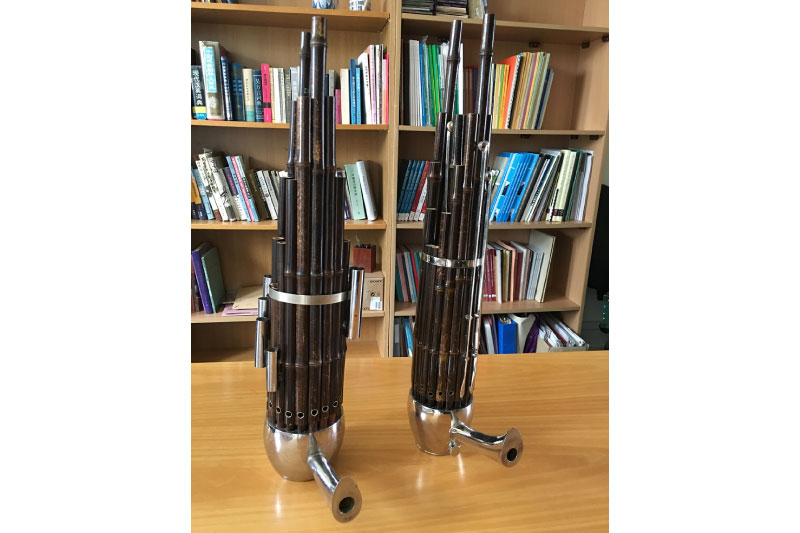
Solo Instruments
Chinese instruments include strings, wind instruments, and percussion. Some of them were originally invented in China, such as the qin (seven-stringed zither), zheng (thirteen-stringed zither), the sheng (a reed-pipe mouth organ, Figure 7), the xun (ocarina, Figure 8), and possibly the dizi (bamboo flute). Groups of percussion instruments (typically drums, cymbals, clappers, and gongs) are used in bands and as accompaniments for ballads and operas (Ying 1997). Many instruments, for instance, the pipa (a plucked lute, Figure 9; Example 11: Performed by Ma Ming-Hui. Courtesy of Ma Ming-Hui.), erhu (two-stringed fiddle), and suona (double-reed oboe, Figure 10) were imported from other countries and then gradually adapted, becoming Chinese traditional instruments over time. While some instruments are nationally distributed, others, like the kouxian (Jew's harp, Example 12: Performed by He Yueyuan. Courtesy of Qian Lijuan.) are most actively used in only one region, in this case in Southwest China.
Among the Hani, the preferred instruments are the sanxian and the sixian (three or four-stringed plucked lutes), which are made in different shapes and sizes. Musician Wu Zhiming (Figure 11) enjoys making these instruments himself (Figure 12). With a Hani father and an Yi mother, he is familiar with the musical traditions of both ethnicities. He now runs a teaching and learning center for Hani music and converts many traditional folk songs into new pieces. Chen Xialing (Example 13: Performed by Chen Xialing on the Hani sanxian. Courtesy of Qian Lijuan) was a student at Wu Zhiming's center and owing to the skills she has acquired, is a local government cultural officer.
Dizi
The dizi, a side-blown bamboo flute with a lengthy documented history (archaeological sites have revealed ancient dizi as early as 168 BCE; Yuan 2000: 296), is widely performed in most areas of China. It was widely used since the Ming dynasty, when a variant called the qudi was used to lead the accompaniment to kunqu opera. In the north, a smaller, higher-pitched, less mellow version called the bangda played an important role in the banziqiang local opera tradition. (Lau 2008: 42-45) These sources give the instrument a richly varied repertory, parts of which have been rearranged as solos over the past hundred years or so, such as 'Partridge Flying' (Example 14, the notation can be seen in Stock 1994: 16-19), which was originally a folk music item from Hunan province. The solo's embellished melodies imitate birdsong.





Hong Kong film stars Sammo Hung and Jackie Chan were classmates at the Beijing Opera School in Hong Kong.











